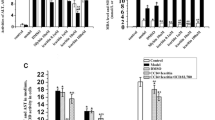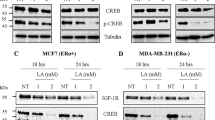Abstract
Oxidative stress plays a causative role in the development of hepatic fibrosis and apoptosis. Estradiol (E2) is an antioxidant, and idoxifene is a tissue-specific selective estrogen-receptor modulator. We have previously demonstrated that E2 inhibits hepatic fibrosis in rat models of hepatic fibrosis and that the actions of E2 are mediated through estrogen receptors (ERs). This study reports on the antiapoptotic role of idoxifene and E2, and the functions of ER subtypes ER-α and ER-β in hepatocytes undergoing oxidative stress. Lipid peroxidation was induced in cultured rat hepatocytes with ferric nitrilotriacetate solution with idoxifene or E2. Oxidative stress-induced early apoptosis was linked to its ability to inhibit not only the expression of Bcl-2 and Bcl-XL but the production of antioxidant enzymes as well and to stimulate Bad expression. Hepatocytes possessed functional ER-β, but not ER-α, to respond directly to idoxifene and E2. Idoxifene and E2 suppressed oxidative stress-induced reactive oxygen species generation and lipid peroxidation, and their antiapoptotic effects on the activation of activator protein-1 and nuclear factor-κB, the loss of antioxidant enzyme activity, and Bcl-2 family protein expression in early apoptotic hepatocytes were blocked by the pure ER antagonist ICI 182,780. Our results indicate that idoxifene and E2 could enhance antiapoptotic activity through ER-β during oxidative damage in hepatocytes.
Similar content being viewed by others
References
Shimizu I: Antifibrogenic therapies in chronic HCV infection. Curr Drug Targets-Infectious Disorders 1:227-240, 2001
Poynard T, Bedossa P, Opolon P: Natural history of liver fibrosis progression in patients with chronic hepatitis C. Lancet 349:825-832, 1997
Shimizu I, Inoue H, Yano M, Shinomiya H, Wada S, Tsuji Y, Tsutsui A, Okamura S, Shibata H, Ito S: Estrogen receptor levels and lipid peroxidation in hepatocellular carcinoma with hepatitis C virus infection. Liver 21:342-349, 2001
Yoshino K, Komura S, Watanabe I, Nakagawa Y, Yagi K: Effect of estrogens on serum and liver lipid peroxide levels in mice. J Clin Biochem Nutr 3:233-239, 1987
Lacort M, Leal AM, Liza M, Martin C, Martinez R, Ruiz-Larrea MB: Protective effect of estrogens and catecholestrogens against peroxidative membrane damage in vitro. Lipids 30:141-146, 1995
Shimizu I: Sho-saiko-to: Japanese herbal medicine for protection against hepatic fibrosis and carcinoma. J Gastroenterol Hepatol 15:D84-D90, 2000
Shimizu I, Mizobuchi Y, Shiba M, Ma Y-R, Horie T, Liu F, Ito S: Inhibitory effect of estradiol on activation of rat hepatic stellate cells in vivo and in vitro. Gut 44:127-136, 1999
Yasuda M, Shimizu I, Shiba M, Ito S: Suppressive effects of estradiol on dimethylnitrosamine-induced fibrosis of the liver in rats. Hepatology 29:719-727, 1999
Omoya T, Shimizu I, Zhou Y, Okamura Y, Inoue H, Lu G, Itonaga M, Honda H, Nomura M, Ito S: Effects of idoxifene and estradiol on NF-κB activation in cultured rat hepatocytes undergoing oxidative stress. Liver 21:183-191, 2001
Shimizu I, Omoya T, Kondo Y, Kusaka Y, Tsutsui A, Shibata H, Honda H, Sano N, Ito S: Estrogen therapy in a male patient with chronic hepatitis C and irradiation-induced testicular dysfunction. Intern Med 40:100-104, 2001
Wang TT, Phang JM: Effects of estrogen on apoptotic pathways in human breast cancer cell line MCF-7. Cancer Res 55:2487-2489, 1995
Garcia-Segura LM, Cardona GP, Naftolin F, Chowen JA: Estradiol upregulates Bcl-2 expression in adult brain neurons. Neuroreport 9:593-597, 1998
Gohel A, McCarthy MB, Gronowicz G: Estrogen prevents glucocorticoid-induced apoptosis in osteoblasts in vivo and in vitro. Endocrinology 140:5339-5347, 1999
Hockenbery DM, Oltvai ZN, Yin XM, Milliman CL, Korsmeyer SJ: Bcl-2 functions in an antioxidant pathway to prevent apoptosis. Cell 75:241-251, 1993
Collaborative Group on Hormonal Factors in Breast Cancer: Breast cancer and hormone replacement therapy: collaborative reanalysis of data from 51 epidemiological studies of 52705 women with breast cancer and 108411 women without breast cancer. Lancet 351:1047-1059, 1997
Treinen KA, Rehm S, Wier PJ: An evaluation of the novel selective estrogen receptor modulator, idoxifene, for effects on reproduction in rats and rabbits. Toxicol Sci 41:199-207, 1998
Johnston SR, Boeddinghaus IM, Riddler S, Haynes BP, Hardcastle IR, Rowlands M, Grimshaw R, Jarman M, Dowsett M: Idoxifene antagonizes estradiol-dependent MCF-7 breast cancer xenograft growth through sustained induction of apoptosis. Cancer Res 59:3646-3651, 1999
Nuttall ME, Bradbeer JN, Stroup GB, Nadeau DP, Hoffman SJ, Zhao H, Rehm S, Gowen M: Idoxifene: a novel selective estrogen receptor modulator prevents bone loss and lowers cholesterol levels in ovariectomized rats and decreases uterine weight in intact rats. Endocrinology 139:5224-5234, 1998
Lindner V, Kim SK, Karas RH, Kuiper GG, Gustafsson JA, Mendelsohn ME: Increased expression of estrogen receptor-β mRNA in male blood vessels after vascular injury. Circ Res 83:224-229, 1998
Zhou Y, Shimizu I, Lu G, Itonaga M, Okamura Y, Shono M, Honda H, Inoue S, Muramatsu M, Ito S: Hepatic stellate cells contain the functional estrogen receptor β but not the estrogen receptor α in male and female rats. Biochem Biophys Res Commun 286:1059-1065, 2001
Wakeling AE, Bowler J: ICI 182,780, a new antioestrogen with clinical potential. J Steroid Biochem Mol Biol 43:173-177, 1992
Shimizu I, Ichihara A, Nakamura T: Hepatocyte growth factor in ascites from patients with cirrhosis. J Biochem 109:14-18, 1991
Shimizu I, Ma Y-R, Mizobuchi Y, Liu F, Miura T, Nakai Y, Yasuda M, Shiba M, Horie T, Amagaya S, Kawada N, Hori H, Ito S: Effects of Sho-saiko-to, a Japanese herbal medicine, on hepatic fibrosis in rats. Hepatology 29:149-160, 1999
Maxwell DP, Wang Y, McIntosh L: The alternative oxidase lowers mitochondrial reactive oxygen production in plant cells. Proc Natl Acad Sci USA 96:8271-8276, 1999
Koike S, Sakai M, Muramatsu M: Molecular cloning and characterization of rat estrogen receptor cDNA. Nucleic Acids Res 15:2499-2513, 1987
Kuiper GG, Enmark E, Pelto-Huikko M, Nilsson S, Gustafsson JA: Cloning of a novel receptor expressed in rat prostate and ovary. Proc Natl Acad Sci USA 93:5925-5930, 1996
Kurosawa H, Que FG, Roberts LR, Fesmier PJ, Gores GJ: Hepatocytes in the bile duct-ligated rat express Bcl-2. Am J Physiol 272:G1587-G1593, 1997
Christensen JG, Gonzales AJ, Cattley RC, Goldsworthy TL: Regulation of apoptosis in mouse hepatocytes and alteration of apoptosis by nongenotoxic carcinogens. Cell Growth Differ 9:815-825, 1998
Rashid A, Wu TC, Huang CC, Chen CH, Lin HZ, Yang SQ, Lee FY, Diehl AM: Mitochondrial proteins that regulate apoptosis and necrosis are induced in mouse fatty liver. Hepatology 29:1131-1138, 1999
Ray SD, Balasubramanian G, Bagchi D, Reddy CS: Ca2+-calmodulin antagonist chlorpromazine and poly(ADP-ribose) polymerase modulators 4-aminobenzamide and nicotinamide influence hepatic expression of BCL-XL and P53 and protect against acetaminophen-induced programmed and unprogrammed cell death in mice. Free Radic Biol Med 31:277-291, 2001
Haidara K, Morel I, Abalea V, Gascon BM, Denizeau F: Mechanism of tert-butylhydroperoxide induced apoptosis in rat hepatocytes: involvement of mitochondria and endoplasmic reticulum. Biochim Biophys Acta 1542:173-185, 2002
Martin SJ, Reutelingsperger CP, McGahon AJ, Rader JA, van Schie RC, LaFace DM, Green DR: Early redistribution of plasma membrane phosphatidylserine is a general feature of apoptosis regardless of the initiating stimulus: inhibition by overexpression of Bcl-2 and Abl. J Exp Med 182:1545-1556, 1995
Paech K, Webb P, Kuiper GG, Nilsson S, Gustafsson J, Kushner PJ, Scanlan TS: Differential ligand activation of estrogen receptors ERα and ERβ at AP1 sites. Science 277:1508-1510, 1997
Paige LA, Christensen DJ, Gron H, Norris JD, Gottlin EB, Padilla KM, Chang CY, Ballas LM, Hamilton PT, McDonnell DP, Fowlkes DM: Estrogen receptor (ER) modulators each induce distinct conformational changes in ER alpha and ER beta. Proc Natl Acad Sci USA 96:3999-4004, 1999
Alvaro D, Alpini G, Onori P, Perego L, Svegliata BG, Franchitto A, Baiocchi L, Glaser SS, Le Sage G, Folli F, Gaudio E: Estrogens stimulate proliferation of intrahepatic biliary epithelium in rats. Gastroenterology 119:1681-1691, 2000
Kuiper GG, Carlsson B, Grandien K, Enmark E, Haggblad J, Nilsson S, Gustafsson JA: Comparison of the ligand binding specificity and transcript tissue distribution of estrogen receptors alpha and beta. Endocrinology 138:863-870, 1997
Brandenberger AW, Tee MK, Lee JY, Chao V, Jaffe RB: Tissue distribution of estrogen receptors alpha (ER-alpha) and beta (ER-beta) mRNA in the midgestational human fetus. J Clin Endocrinol Metab 82:3509-3512, 1997
Maruyama K, Endoh H, Sasaki-Iwaoka H, Kanou H, Shimaya E, Hashimoto S, Kato S, Kawashima H: A novel isoform of rat estrogen receptor beta with 18 amino acid insertion in the ligand binding domain as a putative dominant negative regular of estrogen action. Biochem Biophys Res Commun 246:142-147, 1998
Dickson RB, Eisenfeld AJ: 17 Alpha-ethinyl estradiol is more potent than estradiol in receptor interactions with isolated hepatic parenchymal cells. Endocrinology 108:1511-1518, 1981
Crabb DW, Roepke J: Loss of growth hormone-dependent characteristics of rat hepatocytes in culture. In Vitro Cell Dev Biol 23:303-307, 1987
Omoya T, Shimizu I, Liu F, Honda H, Ito S: Estradiol enhances biological defense activities against oxidative stress and prevents hepatic fibrosis. Hepatology 30:490A, 1999
Osborne MR, Hewer A, Davis W, Strain AJ, Keogh A, Hardcastle IR, Phillips DH: Idoxifene derivatives are less reactive to DNA than tamoxifen derivatives, both chemically and in human and rat liver cells. Carcinogenesis 20:293-297, 1999
Hard GC, Iatropoulos MJ, Jordan K, Radi L, Kaltenberg OP, Imondi AR, Williams GM: Major difference in the hepatocarcinogenicity and DNA adduct forming ability between toremifene and tamoxifen in female Crl:CD(BR) rats. Cancer Res 53:4534-4541, 1993
Fischer-Dzoga K, Wissler RW, Vesselinovitch D: The effect of estradiol on the proliferation of rabbit aortic medial tissue culture cells induced by hyperlipemic serum. Exp Mol Pathol 39:355-363, 1983
Vargas R, Wroblewska B, Rego A, Hatch J, Ramwell PW: Oestradiol inhibits smooth muscle cell proliferation of pig coronary artery. Br J Pharmacol 109:612-617, 1993
Iafrati MD, Karas RH, Aronovitz M, Kim S, Sullivan-TR J, Lubahn DB, O'Donnell-TF J, Korach KS, Mendelsohn ME: Estrogen inhibits the vascular injury response in estrogen receptor alpha-deficient mice. Nat Med 3:545-548, 1997
Bayard F, Clamens S, Meggetto F, Blaes N, Delsol G, Faye JC: Estrogen synthesis, estrogen metabolism, and functional estrogen receptors in rat arterial smooth muscle cells in culture. Endocrinology 136:1523-1529, 1995
Rights and permissions
About this article
Cite this article
Inoue, H., Shimizu, I., Lu, G. et al. Idoxifene and Estradiol Enhance Antiapoptotic Activity Through Estrogen Receptor-β in Cultured Rat Hepatocytes. Dig Dis Sci 48, 570–580 (2003). https://doi.org/10.1023/A:1022553119715
Issue Date:
DOI: https://doi.org/10.1023/A:1022553119715




